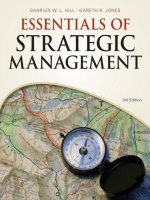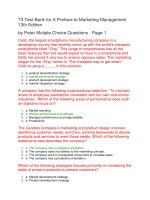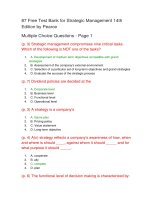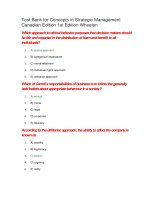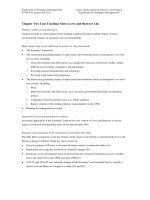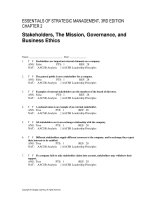Fred r david – strategic management, 13th edition ch03
Bạn đang xem bản rút gọn của tài liệu. Xem và tải ngay bản đầy đủ của tài liệu tại đây (102.63 KB, 36 trang )
Exam
Name___________________________________
TRUE/FALSE. Write 'T' if the statement is true and 'F' if the statement is false.
1)
Industry analysis is also referred to as external strategic management audit.
1)
_______
2)
An external audit focuses on identifying and evaluating trends and events within the control of
management.
2)
_______
3)
The aim of an external audit is to develop an exhaustive list of every possible factor that could influence
the business.
3)
_______
4)
External audits attempt to identify key variables that offer actionable responses.
4)
_______
5)
Five major categories of external variables are 1) economic forces; 2) social and cultural forces; 3) political,
governmental and legal forces; 4) technological forces; and 5) demographic forces.
5)
_______
6)
As many managers and employees as possible should be involved in the process of performing an external
audit.
6)
_______
7)
To perform an external audit, a company first must gather competitive intelligence and information about
social, cultural, demographic, environmental, economic, political, legal, governmental and technological
trends.
7)
_______
8)
Freund argues that key external factors must not be hierarchical.
8)
_______
9)
Research findings suggest that a greater percentage of a firm's profitability can be explained by the
industry than can be explained by the firm's internal factors.
9)
_______
10)
An economic trend in the Arab world is an increasing number of two-income households.
10)
______
11)
Economic factors do not have much impact on the attractiveness of strategies.
11)
______
12)
An increase in interest rates is directly related to an increase in both discretionary income and the demand
for discretionary goods.
12)
______
13)
In Arab countries that are oil producers, government expenditures increase and jobs become more readily
available when oil revenues increase.
13)
______
14)
In some Arab countries, companies that depend heavily on imports benefit greatly when the dollar falls
against the yen and euro.
14)
______
15)
Decreasing demands for oil will significantly impact the economies of many countries in the Middle East
region, as these countries are either oil producers or labor exporters for the oil-producing countries.
15)
______
16)
The Arab region is experiencing little change in terms of social priorities and population changes.
16)
______
17)
The Arab world, in general, has a high rate of birth; and the youth demographic group is one of the largest
in the population.
17)
______
18)
With about 60 percent of its population under 25 years of age, the Arab world is one of the most youthful
regions in the world.
18)
______
19)
The Arab Human Development Report 2009 shows that life expectancy of the Arab population, on average,
jumped from 46 years in 1960 to about 70 in 2005.
19)
______
20)
All Arab countries share a similar culture and have the same ethnic and religious beliefs.
20)
______
21)
Spending on domestic and international travel by Gulf nationals in 2000 amounts to 8.7 percent of the
total personal consumption in the region, and is expected to grow at 5.2 percent per year over the next
decade.
21)
______
22)
Social and demographic trends are not shaping the way the Arabs live, work, produce, and consume.
22)
______
23)
Although the Arab world has one of the highest rates of expansion of the youth demographic in the world,
the growing percentage of the older segment is apparent in some countries.
23)
______
24)
In 2050, approximately a quarter of the populations are expected to be aged 60 years and older in five
Arab countries.
24)
______
25)
Political, governmental, and legal factors are considered key threats for most small and large
organizations.
25)
______
26)
Political forecasts can be the most important part of an external audit for firms that depend heavily on
government contracts.
26)
______
27)
In addition to liberalization, Arab executives have shown an interest in asking their respective governments
to join the World Trade Organization and in protecting the environment.
27)
______
28)
Mass communication and high technology are creating similar patterns of consumption in diverse cultures
worldwide, which means that many companies may find it difficult to survive by relying solely on domestic
markets.
28)
______
29)
Within the European Union (EU), tax rates have been standardized to end competitive tax breaks among
member countries.
29)
______
30)
The Internet is changing the very nature of many industries by altering product life cycles and changing
the historical trade-off between production standardization and flexibility.
30)
______
31)
In practice, critical technology decisions are too often delegated to lower organizational levels or are made
without an understanding of their strategic implications.
31)
______
32)
Pepsi Bottling is the top beverage company in the U.S.
32)
______
33)
Competition in virtually all industries can be described as intense, and sometimes as cutthroat in the Arab
world.
33)
______
34)
"Innovate or evaporate; particularly in technology-driven businesses, nothing quite recedes like success" is
a characteristic of the most competitive companies.
34)
______
35)
Corporate intelligence can be defined as a systematic and ethical process for gathering and analyzing
information about the activities and general business trends of the competition, to further a business's own
goals.
35)
______
36)
Internal opportunities can be represented by major competitors' weaknesses.
36)
______
37)
According to Business Week, there are less than 500 corporate spies now actively engaged in intelligence
activities.
37)
______
38)
According to Business Week, 9 out of 10 large companies have employees dedicated solely to gathering
competitive intelligence.
38)
______
39)
An effective CI program allows all areas of a firm to access consistent and verifiable information in making
decisions.
39)
______
40)
Competitive intelligence is not considered corporate espionage because 95 percent of the information a
company needs to make strategic decisions is available and accessible to the public.
40)
______
41)
Because companies are fearful of corporate espionage, cooperative agreements between competitors are
becoming less popular.
41)
______
42)
Learning from the partner is a major reason why Asian and European firms enter into cooperative
agreements.
42)
______
43)
Market commonality is the extent to which the type and amount of a firm's internal resources are
comparable to a rival.
43)
______
44)
According to Michael Porter, five competitive forces create vital opportunities and threats to organizations
1) new entrants; 2) substitute products or services; 3) bargaining power of suppliers; 4) bargaining power
of buyers; and 5) rivalry among existing firms.
44)
______
45)
The first step for using Porter's Five-Forces Model is to evaluate the relative strength of each competitive
force.
45)
______
46)
The most powerful of Porter's five competitive forces is usually the bargaining power of consumers.
46)
______
47)
Significant barriers to entry are not always sufficient to keep some new firms from entering industries with
higher-quality products, lower prices and substantial marketing resources.
47)
______
48)
Laser eye surgery would be considered a substitute product for eyeglasses and contact lenses.
48)
______
49)
Forward integration is used by firms to gain control or ownership of suppliers.
49)
______
50)
The bargaining power of consumers can be the most important force impacting competitive advantage.
50)
______
51)
Forecasts are educated assumptions about future trends and events.
51)
______
52)
Qualitative forecasts are most appropriate when historical data are available, and when the relationships
among key variables are expected to remain the same in the future.
52)
______
53)
Quantitative forecasts become less accurate as historical relationships become less stable.
53)
______
54)
Linear regression is based on the assumption that the future will be different from the past.
54)
______
55)
Linear regression is a popular technique for qualitative forecasts.
55)
______
56)
Without reasonable assumptions, the strategy-formulation process could not proceed effectively.
56)
______
57)
Globalization is a process of worldwide integration of strategy formulation, implementation and evaluation
activities.
57)
______
58)
A global strategy seeks to meet the needs of customers worldwide with the lowest cost at the highest
value.
58)
______
59)
A global strategy includes designing, producing, and marketing products with global needs in mind, instead
of considering individual countries alone.
59)
______
60)
It is clear that different industries become domestic for different reasons.
60)
______
61)
An EFE Matrix does not alow strategists to summarize and evaluate economic, social, cultural,
demographic, environmental, political, governmental, legal, technological, and competitive information.
61)
______
62)
In an External Factor Evaluation Matrix, opportunities often receive higher weights than threats, but threats
too can receive high weights if they are especially severe or threatening.
62)
______
63)
Regardless of the number of key opportunities and threats included in an External Factor Evaluation Matrix,
the highest possible total weighted score for an organization is 4.0, and the lowest possible total weighted
score is 0.0.
63)
______
64)
A Competitive Profile Matrix allows strategists to summarize and evaluate economic, social, cultural,
demographic, environmental, political, governmental, legal, technological, and competitive information.
64)
______
65)
Both a Competitive Profile Matrix and an EFE Matrix have the same meaning in the weights, ratings and
total weighted scores.
65)
______
66)
The critical success factors in a Competitive Profile Matrix are often the same as those in an EFE Matrix.
66)
______
MULTIPLE CHOICE. Choose the one alternative that best completes the statement or answers
the question.
67)
________ is not part of an external audit.
67)
______
A)
Studying the political environment
B)
Analyzing social, cultural, demographic and geographic forces
C)
Analyzing financial ratios
D)
Analyzing available technologies
E)
Analyzing competitors
68)
Identifying and evaluating key social, political, economic, technological and competitive trends and events
are the main components of
68)
______
A)
performing an external audit.
B)
formulating strategy.
C)
developing an effective mission statement.
D)
conducting an internal audit.
E)
implementing strategy.
69)
The process of performing an external audit needs to include
69)
______
A)
as many managers and employees as possible.
B)
between 15 to 20 managers for it to be valid
C)
stockholders and external government agencies
D)
primarily front-line supervisors
E)
only top level managers, as it's a planning function.
70)
To perform an external audit, a company first must
70)
______
A)
get an approval from the Securities and Exchange Commission.
B)
perform an internal audit.
C)
hire a consultant to develop a comprehensive strategic plan.
D)
gather competitive intelligence and information about external trends.
E)
all of these
71)
Freund emphasizes that key external factors should be all of these except
71)
______
A)
measurable.
B)
hierarchical in the sense that some will pertain to the overall company while others will be more narrowly
focused.
C)
important for achieving long-term and annual objectives.
D)
applicable to all competing firms.
E)
relatively few in number.
72)
The I/O approach to competitive advantage argues that external factors are ________ internal factors in a
firm achieving competitive advantage.
72)
______
A)
more important than
B)
less important than
C)
less common than
D)
more common than
E)
as important as
73)
According to I/O theorists, which of the following contributes least to firm performance?
73)
______
A)
Economies of scale
B)
Product differentiation
C)
Internal resources
D)
Barriers to market entry
E)
Level of competitiveness
74)
What happens to the demand for discretionary goods when interest rates rise?
74)
______
A)
It declines.
B)
It stays the same.
C)
There is no way to tell.
D)
It first rises then declines.
E)
It rises.
75)
The effect of trends in the dollar's value on companies in different industries and in different locations are
75)
______
A)
significant and equal.
B)
neglibible.
C)
significant and unequal.
D)
insignificant and unequal.
E)
marginal and equal.
76)
Generally, at the present time, a high worldwide demand for ________ generates more revenue for Arab
countries and allows these countries to invest in various economic sectors.
76)
______
A)
gold
B)
food
C)
steel
D)
diamond
E)
oil
77)
The Arab world has just over _____ million people.
77)
______
A)
200
B)
250
C)
300
D)
350
E)
400
78)
Which of the following was a small village in the 1960s and is now a thriving world city?
78)
______
A)
Manama
B)
Muscat
C)
Jeddah
D)
Dubai
E)
Abu Dhabi
79)
Which Arab country or territory has the highest percentage of population aged 60 years and older as of
2000 ?
79)
______
A)
Lebanon
B)
Yemen
C)
Algeria
D)
Djibouti
E)
Tunisia
80)
Which Arab country or territory will have the highest percentage of population aged 60 years and older as
of 2050 ?
80)
______
A)
Comoros
B)
Sudan
C)
Kuwait
D)
Bahrain
E)
UAE
81)
Who are the world's longest-living people?
81)
______
A)
Americans
B)
Japanese
C)
Filipinos
D)
Indians
E)
Egyptians
82)
Older population segments are especially interested in
82)
______
A)
crime prevention.
B)
financial servoces.
C)
travel and leisure.
D)
health care.
E)
All the above.
83)
Which large ethinic minority in North Africa contributes significantly to the economic prosperity and
development of the area?
83)
______
A)
Berber
B)
Moroccan
C)
Indian
D)
Kenyan
E)
British
84)
When an industry relies heavily on government contracts, which forecasts can be the most important part
of an external audit?
84)
______
A)
Competitive
B)
Political
C)
Multinational
D)
Economic
E)
Technological
85)
Which of these does not significantly affect firms?
85)
______
A)
Lobbying activities
B)
Constitutional laws
C)
Antitrust legislation
D)
Tax rates
E)
Patent laws
86)
Some countries that have petitioned to be admitted to the EU include
86)
______
A)
Ukraine
B)
Georgia
C)
Turkey
D)
Croatia
E)
All the above
87)
Which company has survived as a manufacturer of inexpensive audio products by centralizing its world
production in Singapore?
87)
______
A)
Sony
B)
Panasonic
C)
Hewlett-Packard
D)
Philips
E)
General Electric
88)
Which country is Japan's largest trading partner?
88)
______
A)
U.S.
B)
UAE
C)
China
D)
U.K.
E)
Germany
89)
The term that refers to the EU's effort to end competitive tax breaks among member countries is
89)
______
A)
tax harmonization.
B)
double taxation.
C)
equity taxation.
D)
taxation bias.
E)
tax reconciliation.
90)
Technological advancements can create new ________ advantages that are more powerful than existing
advantages.
90)
______
A)
competitive
B)
social
C)
environmental
D)
economic
E)
comparative
91)
Which is an important sector of the economy for a number of Arab countries highly vulnerable to climate
change?
91)
______
A)
Food production
B)
Metals
C)
Textiles
D)
Paper
E)
Tourism
92)
Collecting and evaluating information on competitors is essential for successful
92)
______
A)
strategy formulation.
B)
strategy management.
C)
strategy implementation.
D)
strategy evaluation.
E)
internal analysis.
93)
In 2010, which company had the dominant market share in the beverages industry?
93)
______
A)
Coca-Cola Enterprises
B)
Molson Brewing
C)
Coca Cola
D)
PepsiCo
E)
Dr Pepper Snapple Group
94)
The term used to describe the systematic and ethical process for gathering and analyzing information
about the competition's activities and general trends to further a business' own goals is
94)
______
A)
unethical business practice.
B)
information sharing.
C)
artificial intelligence.
D)
competitive intelligence.
E)
competitive advantage.
95)
________ is not a basic mission of a competitive intelligence program.
95)
______
A)
To provide a general understanding of an industry
B)
To identify industry executives who could be hired by the firm
C)
To provide a general understanding of a company's competitors
D)
To identify areas where competitors are vulnerable and to assess the impact strategic actions would have
on competitors
E)
To identify potential moves a competitor might make that would endanger a firm's position in the market
96)
Which statement about business intelligence is least accurate?
96)
______
A)
Running an intelligence program requires many people.
B)
Intelligence gathering is an unethical business practice.
C)
Business intelligence is equal to espionage.
D)
Collecting intelligence about competitors violates antitrust laws.
E)
Running an intelligence program requires many computers and other resources.
97)
Keeping strategies secret from employees and stakeholders can do all of the following except
97)
______
A)
provide competitive advantage to competitors.
B)
inhibit employee and stakeholder understanding.
C)
forego valuable employee or stakeholder input.
D)
inhibit employee and stakeholder communication.
E)
inhibit employee and stakeholder commitment.
98)
Learning from the partner is a major reason why ________ firms enter into cooperative agreements.
98)
______
A)
American
B)
Asian
C)
Mexican
D)
African
E)
European
99)
Intensity of competition ________ in lower-return industries.
99)
______
A)
fluctuates
B)
is lowest
C)
is non-existent
D)
is highest
E)
is not important
100)
What is not one of Michael Porter's five competitive forces?
100)
_____
A)
Bargaining power of suppliers
B)
Bargaining power of buyers
C)
Rivalry among existing firms
D)
Bargaining power of unions
E)
New entrants
101)
According to Porter, what is usually the most powerful of the five competitive forces?
101)
_____
A)
Rivalry among competing firms
B)
Potential entry of new competitors
C)
Bargaining power of consumers
D)
Bargaining power of suppliers
E)
Potential development of substitute products
102)
Whenever new firms can easily enter a particular industry, the intensity of competitiveness among firms
102)
_____
A)
stays the same.
B)
neutralizes.
C)
increases.
D)
decreases.
fluctuates.
E)
103)
If suppliers are unreliable or too costly, which of these strategies may be appropriate?
103)
_____
A)
Backward integration
B)
Forward integration
C)
Market penetration
D)
Horizontal integration
E)
Concentric diversification
104)
What level of bargaining power do consumers have when the products being purchased are standard or
undifferentiated?
104)
_____
A)
Marginal
B)
Not necessary
C)
High
D)
Negative
E)
Low
105)
Because of the Internet, barriers to personal and business success are
105)
_____
A)
being eliminated.
B)
significantly enhanced.
